It was just over one year ago that my husband and I killed and butchered Red the pig. That single event informed my eating more than any other ever has. A Vegetarian Slaughters a Pig
At the time of the slaughter, I was a vegetarian, as I had been for a decade. I didn't eat meat for many reasons. Chief among them was that I didn't know how to assess the quality of the animal's life and I was uncomfortable with slaughter.
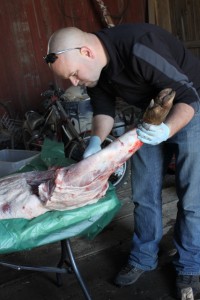 When I met Red, I could sense she was a happy animal. She had been given ample opportunity in her life to explore the land around her, eat like a pig, live with other creatures and roam with ample space.
When I met Red, I could sense she was a happy animal. She had been given ample opportunity in her life to explore the land around her, eat like a pig, live with other creatures and roam with ample space.
The moment of her death was stunning in how very not dramatic it was. I expected horror for some reason, and the end of her life was anything but. Alex carefully aimed a rifle, shot once, and she knocked over dead. It was as simple as the pulling of a dandelion weed or plucking of basil leaves.
As soon as Red died, we went to work butchering the meat. There was an overwhelming sense that what was killed at our hands must be used completely and well.
Beginning to Eat Meat
After the slaughter my attitude towards eating meat began to change. I started to realize that the designation I had made, that eating plants was ok and animals was not, was totally arbitrary.
When my husband grilled Red's ribs for his birthday dinner, I couldn't help but try them. I had seen with my own eyes the kindness of Red's life and her honorable death. I had participated in saving every part of her body and I wanted to participate in the consumption. I began eating meat that I knew had lived a good life.
Everything is a Sacrifice
"It had a nice life and then you killed it?!" is the accusation I have heard more than once from incredulous vegan friends. I hear the point: who are we humans to decide the end of a life?
In contemplating all the foods we cook, I realized that this choice happens with every meal that we eat, indeed every decision we make.
The tomatoes I grow and harvest are hard wired for reproduction. Whether they have feelings or not, their leaves and stems clearly gather water, nutrients, and sunlight for one goal: to make flower to fruit to seed to new plant.
If I pluck a ripe Julia Child heirloom tomato to chop and eat, am I not choosing to break that life cycle?
When I yank spinach plants from the garden bed after the weather has turned hot and they begin to bolt, I am intentionally depriving them of setting seeds and reproducing. I totally control the end of their nice life.
When I buy strawberries out of season shipped across the country, even if they are organic, there is no way they can possibly set seed and start new strawberry plants. On a bigger scale, the contaminants released by long-hauling crops thousands of miles deprive many species of clean air and may introduce reproduction-intercepting chemicals. We are negatively affecting our own personal and species health when we choose to consume well-traveled foods.
Realignment
I realized, in the examination of my feelings following the slaughter of Red, that my line in the sand was wrong. Killing a pig has no less value than killing a lettuce by eating the whole plant. They are both interruptions of the life cycle, choices I make to feed myself.
I suppose someone could argue that given the right conditions a fruit could re-seed itself whereas a dead animal will never make new life. Indeed volunteer tomatoes do always show up around my compost bin. But the staples of most non-animal diets - grains, leafy greens, tree fruits, root vegetables - are 'dead' in that they can no longer grow or reproduce, just like Red.
It took killing a pig to match my values to my diet. If all ingredients are dead, it is my belief that I must make sure their killing is humane and justified. I must use every part of the plants and animals I consume.
It is fitting that the last piece of Red left in the freezer, almost exactly a year after her death, was the loin, the subject of this month's Charcutepalooza Canadian bacon challenge.
As the smoke curled over the brined loin, I had time to reflect on Red's year-long journey. The act of knowing my food to the moment of its death transformed my thinking about what I eat and why. In the end I am left with gratitude that I have a chance to reflect and the opportunity to make choices about my food. Thank you, Red, and all edible plant and animal creatures, for feeding me.
Added to Fight Back Friday April 15 and Charcutepalooza April.

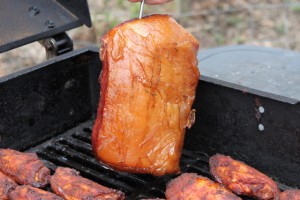


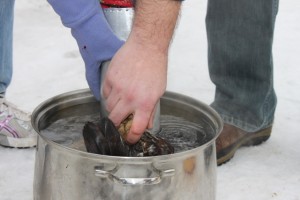
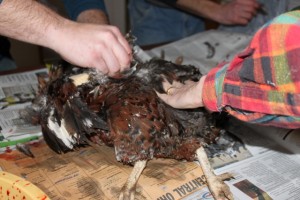


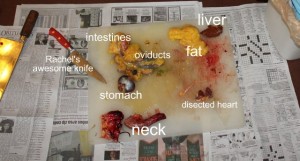


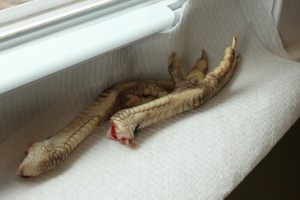
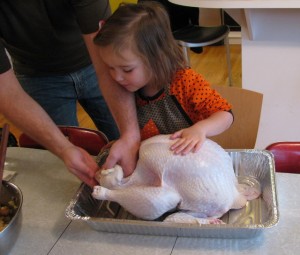


 Meet Red. She's the pig we slaughtered last Saturday with the able assistance of another meat lover,
Meet Red. She's the pig we slaughtered last Saturday with the able assistance of another meat lover,  The kill shot was perfect. Red fell with not so much as a peep. She convulsed involuntarily for about a minute as all large animals do.
The kill shot was perfect. Red fell with not so much as a peep. She convulsed involuntarily for about a minute as all large animals do. Denise felt for the juglar and cut a slit in the throat to drain the blood. The blood was drained into a sterile bucket so that it could be used in making blood sausage.
Denise felt for the juglar and cut a slit in the throat to drain the blood. The blood was drained into a sterile bucket so that it could be used in making blood sausage. It took nearly a quarter hour to capture the blood. When the stream finally slowed to a drop a minute, we moved on to gutting.
It took nearly a quarter hour to capture the blood. When the stream finally slowed to a drop a minute, we moved on to gutting. Denise ran a sharp knife carefully through the center line. She was aiming for just through the skin but accidentally made a small cut into the small intestine. Small intestine contents smell and are a source of bacteria so we worked quickly to clean up the mess and remove the guts.
Denise ran a sharp knife carefully through the center line. She was aiming for just through the skin but accidentally made a small cut into the small intestine. Small intestine contents smell and are a source of bacteria so we worked quickly to clean up the mess and remove the guts. We discarded the intestines. Though they can be used for sausage casing, we had neither the skill nor time to process the intestines as carefully as is required for use. Other organs (liver, kidneys, pancreas, heart) were reserved for offal recipes.
We discarded the intestines. Though they can be used for sausage casing, we had neither the skill nor time to process the intestines as carefully as is required for use. Other organs (liver, kidneys, pancreas, heart) were reserved for offal recipes.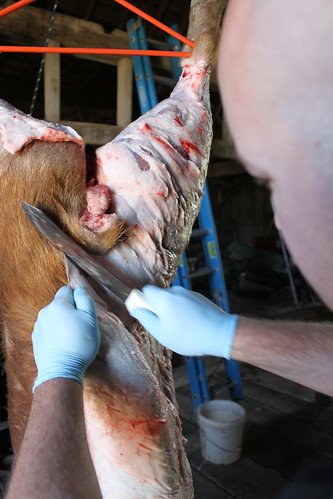 Then skinning began from the legs down. We took turns running sharp knives halfway between the skin and meat so as to retain as much fat as possible. It took almost 45 minutes to completely skin the pig.
Then skinning began from the legs down. We took turns running sharp knives halfway between the skin and meat so as to retain as much fat as possible. It took almost 45 minutes to completely skin the pig.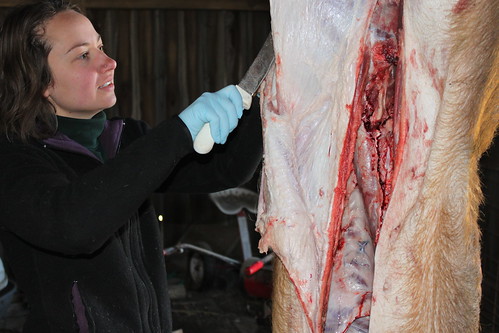
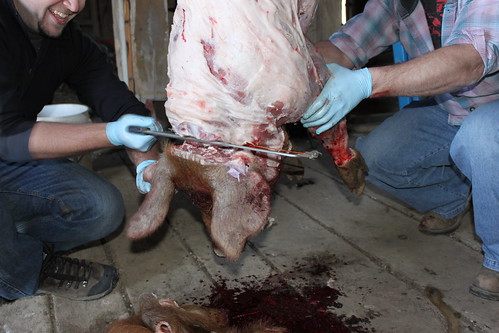
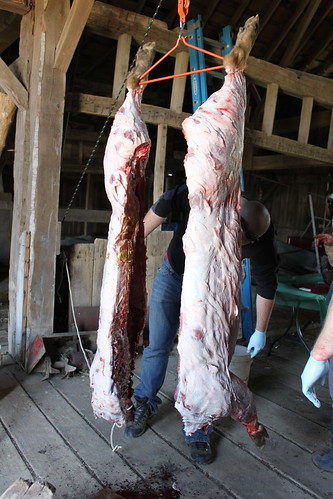
 We carted the coolers home for further processing. Alex butchered while I ran the
We carted the coolers home for further processing. Alex butchered while I ran the 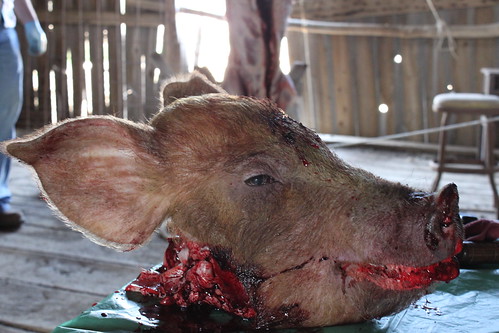
 A few months ago, Denise Beno from
A few months ago, Denise Beno from